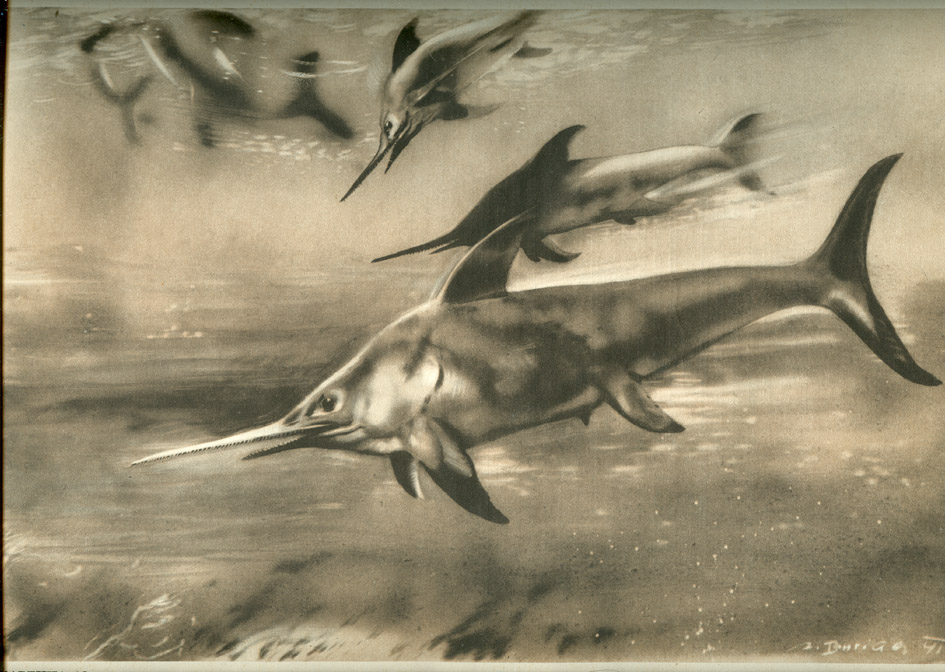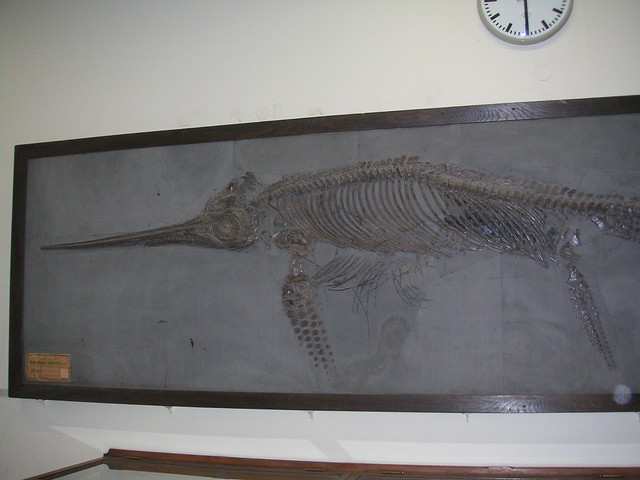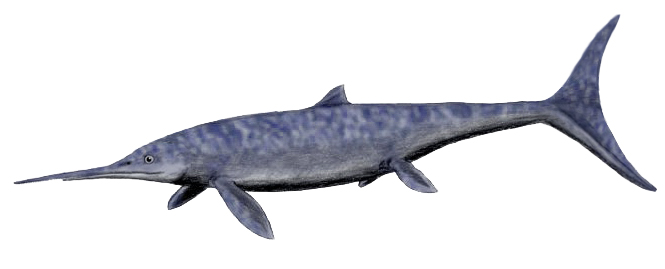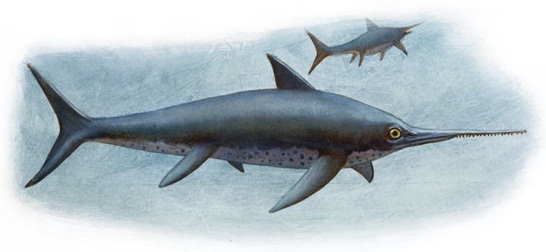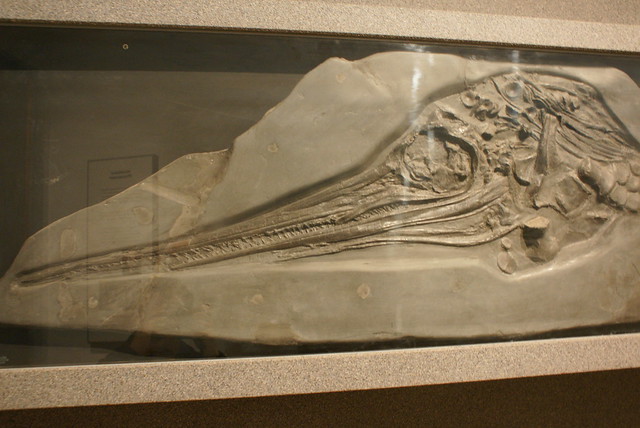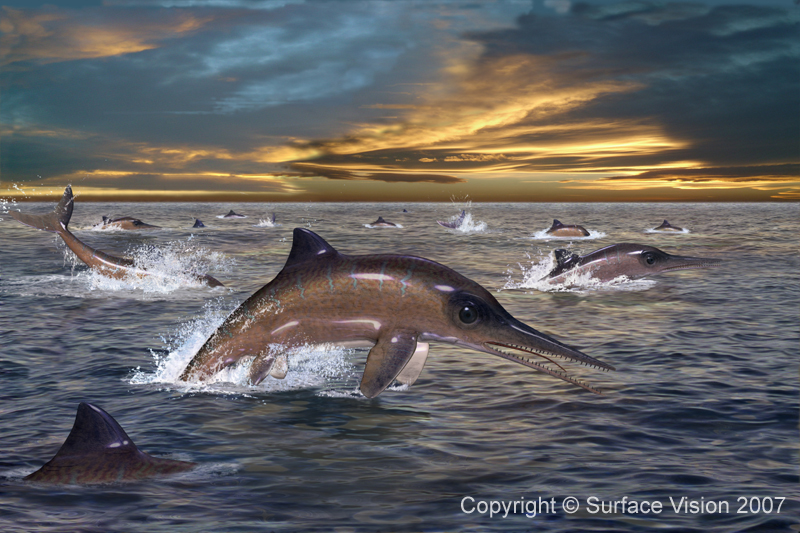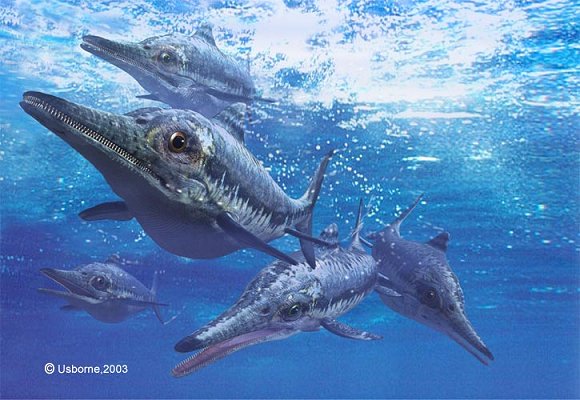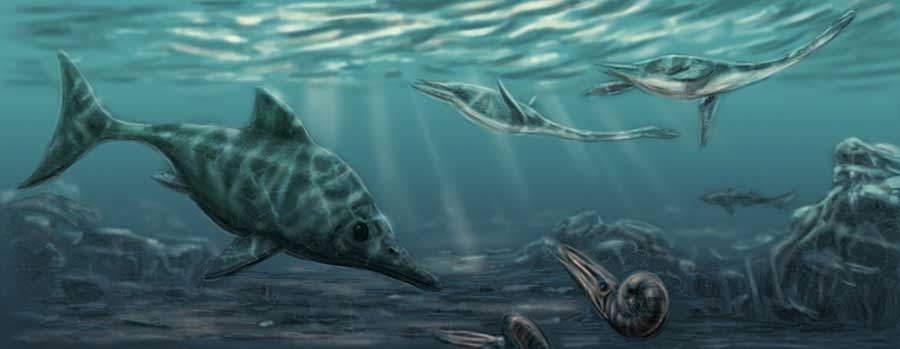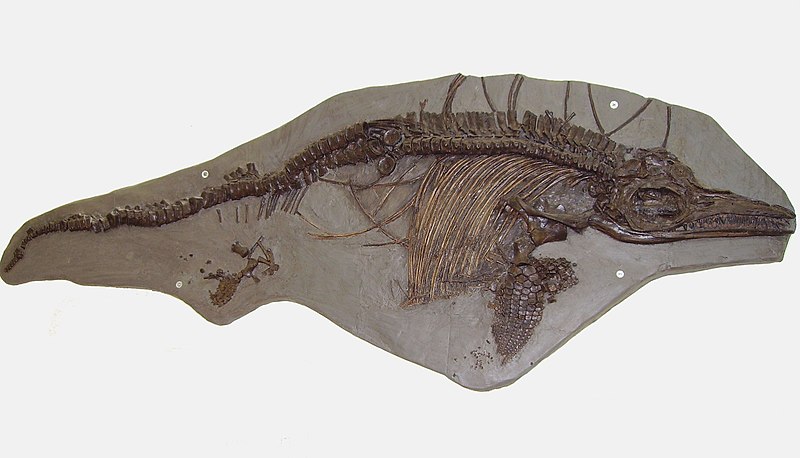[Recent Entries][Archive][Friends][User Info]
April 9th, 2012
| April 9th, 2012 | |
|---|---|
| 07:42 pm [industrialterro] [Link] |
Pleurosaurus Pleurosaurus is an extinct genus of diapsid reptile belonging to the order Sphenodontia, and therefore related to the modern tuatara. Pleurosaurus fossils were discovered in the Solnhofen limestone formation of Bavaria, Germany. Pleurosaurus is one of the few known aquatic sphenodontians. Its body was approximately 60 centimetres (2.0 ft) long, and elongated for hydrodynamic streamlining, with comparatively short limbs and a powerful tail. It would have been able to swim rapidly, by undulating its slender body in a snake-like fashion. It had only small limbs, which probably did not aid in swimming, and nostrils placed far back on the head, close to the eyes. Плеврозавры (Pleurosauridae) — семейство вымерших морских диапсидных рептилий из отряда клювоголовых (Sphenodontia). Останки этого семейства были найдены в Баварии в отложениях юрского и мелового периода.
Ископаемые останки (1, 2, 3, 4, 5, 6):
Tags: Вымершие рептилии, Юра, диапсиды, клювоголовые, лепидозавроморфы, лепидозавры |
| Time | Event |
| 08:13 pm [industrialterro] [Link] |
Aegirosaurus Aegirosaurus is an extinct genus of platypterygiine ophthalmosaurid ichthyosaur known from the Late Jurassic and Early Cretaceous of Europe. Originally described by Wagner (1853) as Ichthyosaurus leptospondylus, it has had an unstable taxonomic history. It has also been named Ichthyosaurus trigonus posthumus, and identified with Macropterygius and Brachypterygius extremus. In 2000, Bardet and Fernández found that the holotype specimen of Macropterygius is undiagnosible, thus this genus is a nomen dubium. They selected a complete skeleton in a private collection as the neotype for this species, as the only other described specimen was destroyed in World War II. A second specimen from the Munich collection was referred to the same taxon. Bardet and Fernández concluded that the neotype should be assigned to a new genus, Aegirosaurus. The name means 'Aegir (teutonic god of the ocean) lizard with slender vertebrae'. Within Ophthalmosauridae, Aegirosaurus was regarded to be most closely related to Ophthalmosaurus. However, many recent cladistic analyses found it to be more closely related to Sveltonectes (and probably to Undorosaurus). Aegirosaurus lineage was found to include Brachypterygius and Maiaspondylus too, and to nest within Platypterygiinae which is the sister taxon of Ophthalmosaurinae. Aegirosaurus is known from the lower Tithonian (Upper Jurassic) of Bavaria, Germany. Its remains were discovered in the Solnhofen limestone formations, the same formations that have yielded numerous well-known fossils, such as Archaeopteryx, Compsognathus and Pterodactylus. In addition to its late Jurassic occurrence, Aegirosaurus has recently been discovered from the late Valanginian (Early Cretaceous) of Southeastern France (Laux-Montaux, department of Drôme; Vocontian Basin), the first diagnostic ichthyosaur recorded from the Valanginian. This shows that most types of Late Jurassic ichthyosaurs crossed the Jurassic-Cretaceous boundary.
Tags: Вымершие рептилии, Юра, диапсиды, ихтиозавры, ихтиоптеригии, офтальмозавриды, платиптеригии |
| Time | Event |
| 08:24 pm [industrialterro] [Link] |
Brachypterygius Brachypterygius is an extinct genus of platypterygiine ophthalmosaurid ichthyosaur known from England and European Russia. Brachypterygius was named by Friedrich von Huene in 1922 and the type species is therefore Brachypterygius extremus. The holotype of B. extremus is known from Kimmeridgian stage of the Late Jurassic of Kimmeridge Clay, area of Bath, England. McGowan, 1976 named a new genus of ichthyosaur, Grendelius mordax from Kimmeridgian stage of Kimmeridge Clay, Norfolk. In 1997, McGowan described additional specimens of the same taxon from the Kimmeridge Bay, Dorset, and referred it to a species of Brachypterygius. Efimov, 1998 named a new genus of ichthyosaur, Otschevia pseudoscythia on the basis of a single specimen (the holotype) from the Pseudoscythia Zone (late Tithonian stage of the Late Jurassic) of Ulyanovsk, Volga region, Russia. Later, Arkangelsky, 1998 described Brachypterygius zhuravlevi from a Tithonian-stage locality in Saratov, Russia. Maisch & Matzke, 2000 considered both russian taxa to be synonyms of each other, and referred the new combination B. pseudoscythius to Brachypterygius. Thus, Grendelius and Otschevia are considered to be junior synonyms of Brachypterygius. Brachypterygius is closely related to Platypterygius and Caypullisaurus. Maisch, 2010 also referred Ochevia alekseevi (named by Arkangelsky, 2001 from the late Jurassic of Russia) and an ichthyosaur from the Early Cretaceous of England to this genus.
Tags: Вымершие рептилии, Юра, диапсиды, ихтиозавры, ихтиоптеригии, офтальмозавриды, платиптеригии |
| Time | Event |
| 08:33 pm [industrialterro] [Link] |
Caypullisaurus Caypullisaurus is an extinct genus of large platypterygiine ophthalmosaurid ichthyosaur from the Late Jurassic to the Early Cretaceous (Tithonian and Berriasian stages) of Argentina. Its holotype was collected from the Vaca Muerta Formation of Cerro Lotena, Neuquen, dating to the early Tithonian stage of the Late Jurassic, about 150 million years ago. Caypullisaurus was first named by Marta Fernández in 1997 and the type species is Caypullisaurus bonapartei. It is a member of the family Ophthalmosauridae, and closely related to Platypterygius and Brachypterygius. In 2012, Caypullisaurus was found to be most closely related to Athabascasaurus and "Platypterygius" australis, and to nest within the subfamily Platypterygiinae.
Tags: Вымершие рептилии, Юра, диапсиды, ихтиозавры, ихтиоптеригии, офтальмозавриды, платиптеригии |
| Time | Event |
| 08:43 pm [industrialterro] [Link] |
Eurhinosaurus Eurhinosaurus ('well-nosed lizard') is an extinct genus of ichthyosaur from the Early Jurassic (Sinemurian - Toarcian) of Europe (England, Germany, Benelux, France & Switzerland). It was a large genus, exceeding 6 m in length. Eurhinosaurus looked like a regular ichthyosaur, with a fish-like body including a dorsal and caudal fin, and large eyes, but had one distinct feature that set it apart from other ichthyosaurs. Its upper jaw was twice as long as the lower jaw and covered with sidewards-pointing 'teeth', like the sawfish's. It might have been used to search vegetation and crustaceans on the ocean bottom for prey by swinging its upper jaw from side to side against the sea floor like a sawfish, or to violently stab prey to death like swordfish, sailfish and marlins. A Miocene cetacean, Eurhinodelphis, also developed a similar structure. В морях мезозоя жило много различных видов и родов ихтиозавров. Одним из наиболее интересных представителей этих животных был Eurhinosaurus longirostris, обитавший в ранне-юрских морях на территории нынешней южной Германии. Одной из особенностей этого животного была неодинаковая длина челюстей. Причина этого точно не известна. Нет почти ни одного крупного музея, в палеонтологических коллекциях которого не было бы останков ихтиозавра из этих слоев. Подобно спрессованным листьям гербария, скелеты этих хищных морских ящеров покоятся на темных сланцевых плитах.
Ископаемые останки (1, 2, 3, 4, 5, 6, 7, 8):
Tags: Вымершие рептилии, Юра, диапсиды, ихтиозавры, ихтиоптеригии |
| Time | Event |
| 09:20 pm [industrialterro] [Link] |
Excalibosaurus Excalibosaurus (meaning "Excalibur's lizard") is a monotypic genus of marine prehistoric fish-like reptiles (ichthyosaurs) that lived during the Sinemurian stage (approximately 196.5 ± 2 Ma to 189.6 ± 1.5 Ma (million years ago)) of the Early Jurassic period in what is now England. It is characterized by the extreme elongation of the rostrum, with the lower jaw about three fourth of the length of the upper jaw, giving the animal a swordfish-like look. The only known species is Excalibosaurus costini. This relatively rare animal is known from two skeletons. The holotype, discovered in 1984 near a beach on the Somerset coast, consists of the skull, forefin, part of the pectoral girdle and some vertebrae and ribs. It has been described in 1986 by McGowan. The fossil is hosted in the Bristol City Museum and Art Gallery. The second specimen is an almost complete skeleton collected in the same area in 1996, and was purchased by the Royal Ontario Museum. It was described again by McGowan in 2003. Excalibosaurus is related to two other genera of ichthyosaurs, Leptonectes from the Rhaetian (Late Triassic) to the Sinemurian (Early Jurassic) of England and Eurhinosaurus from the Toarcian (Early Jurassic) of Germany. The three genera are grouped in the family Leptopterygiidae and the suborder Eurhinosauria. It was once thought that Excalibosaurus was a junior synonym of Eurhinosaurus, but the description of the 1996 specimen show many morphological differences such as the shape of the forefin (much shorter and broader in Excalibosaurus), the slender shape of the body, that clearly differentiate the two genera. The estimate body length of the 1996 specimen is 7 m with a 1.54 m long skull. The holotype specimen was much smaller, with a skull length of 0.785 m and an estimated body length of 4 m, indicating that it was a juvenile.
Размеры тела в сравнении с человеком:
Tags: Вымершие рептилии, Юра, диапсиды, ихтиозавры, ихтиоптеригии |
| Time | Event |
| 09:33 pm [industrialterro] [Link] |
Ichthyosaurus Ichthyosaurus (derived from Greek ιχθυς/ichthys meaning 'fish' and σαυρος/sauros meaning 'lizard') is a genus of ichthyosaurs from the early Jurassic (Hettangian - Sinemurian) of Europe (Belgium, England, Switzerland). It is among the best known ichthyosaur genera, with the Order Ichthyosauria being named after it. Ichthyosaurus was the first complete fossil to be discovered in the early 19th century by Mary Anning in England. Ichthyosaurus were smaller than most of their relatives, with individuals measuring up to 2 metres (6.6 ft) in length. Hundreds of well-preserved, fossilised skeletons have been found in Jurassic rock at Holzmaden, Germany. Some of the bones were still articulated. Some fossils still had baby specimens inside them, indicating that Ichthyosaurus was viviparous. Similar finds in the related Stenopterygius also show this. The German fossils also featured the outline of Ichthyosaurus's skin, revealing that it had a fleshy dorsal fin on its back and a large caudal fin. Other ichthyosaur fossils showed this feature was not limited to Ichthyosaurus. Ichthyosaurus ear bones were solid, probably transferring water vibrations to the inner ear. Still, hunting by sight was the creature's main feeding activity; it had huge, sensitive eyes, protected by bony shields. Coprolites of Ichthyosaurus reveal that its diet consisted of fish and squid. It was initially believed that Ichthyosaurus laid eggs on land, but fossil evidence shows that in fact the females gave birth to live young. As such, they were well-adapted to life as fully pelagic organisms (i.e. they never came onto land). The babies were born tail first to prevent them from drowning in the water.
Репродукции (1, 2, 3, 4, 5, 6, 7, 8, 9, 10, 11, 12):
( Далее ) Размеры тела в сравнении с человеком:
Ископаемые останки (1, 2, 3, 4, 5, 6, 7, 8, 9):
( Далее ) Tags: Вымершие рептилии, Юра, диапсиды, ихтиозавры, ихтиоптеригии |
| Previous Day | 2012/04/09 [Archive] |
Next Day |














